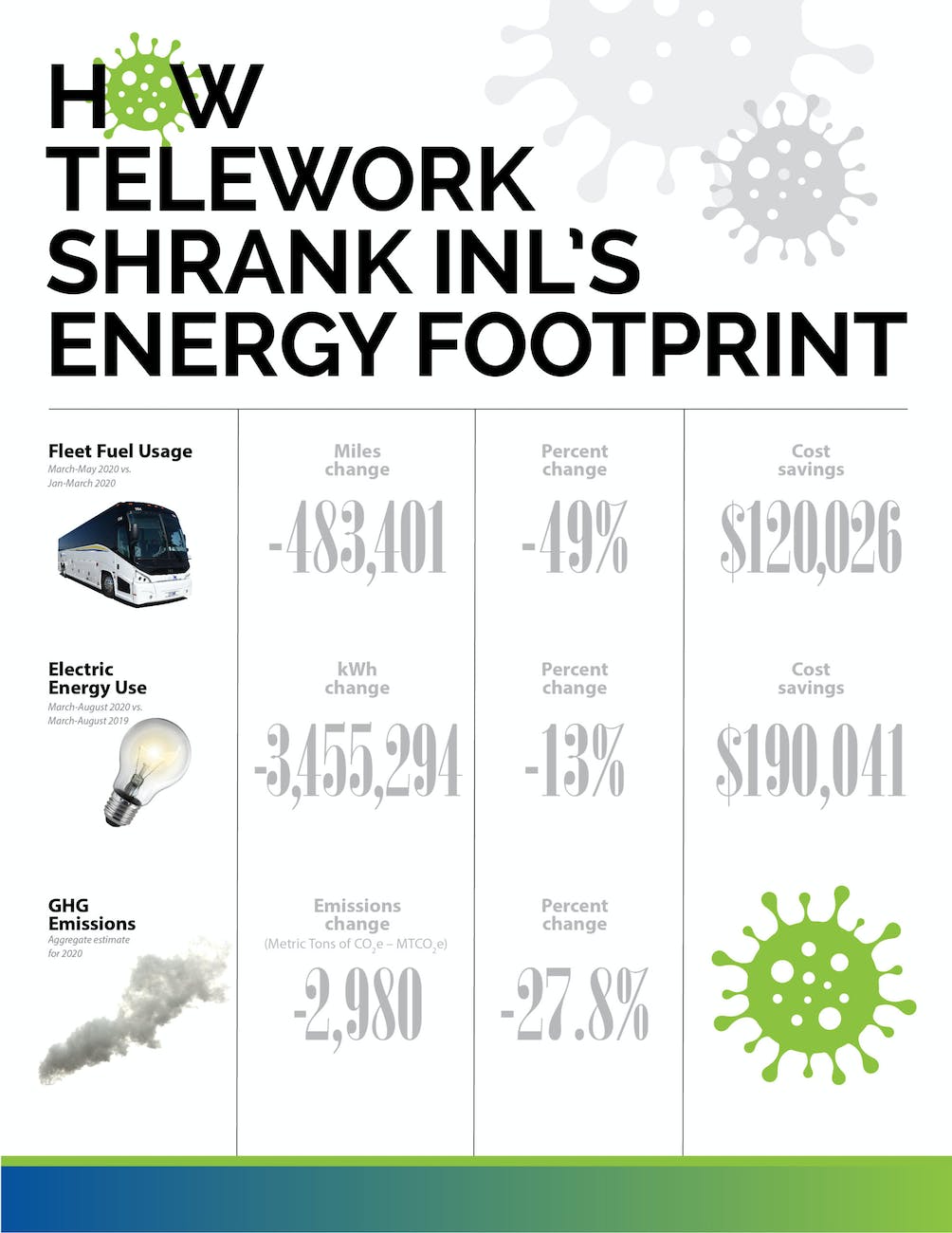If you’re in charge of keeping track of such things as energy use, water consumption and recycling at a company, you’d naturally expect to see numbers drop when 3,500 people are told to go home and work from there.
In this respect, 2020 numbers from Idaho National Laboratory offer little in the way of surprises, said Ernest Fossum, the lab’s energy manager.
In mid-March, as the gravity of the COVID-19 pandemic became evident, INL management ordered home all but those employees engaged keeping the site safe. Over six months – March through August – INL saw an overall cost reduction of $310,067 in fleet fuels and electrical energy.
Sustainability goals
Sustainability was already a goal for INL and its leadership. In December 2019, the lab issued the updated Site Sustainability Plan and launched the Sustainable INL Program, defining strategies and activities to move INL closer to the U.S. Department of Energy’s sustainability goals and requirements. The disruption caused by the pandemic has shed new light on how those goals might be met.
“In the 30 years I’ve worked here, I’ve never experienced anything quite like this before,” Fossum said. “None of these resource reductions were planned. They are benefits we didn’t try to get, but they happened because of where we went as a company.”
Working from home has forced many INL employees into totally new patterns, said Maryl Fisher, an INL sustainability analyst. While many might have had experience with teleconferencing tools such as Microsoft Teams, it’s a safe bet that few used them to the extent they have since the pandemic hit in March.
“We’ve learned how to use electronic resources better because we’ve had to,” she said. “It was a chance to learn maybe faster than we wanted.”
People at home are most likely using a lot less paper than they did at the office, said Fossum. “When I was in the office every day, I had no problem printing out anything I thought I needed,” he said. “Now that I am working from home, it got me asking the question, ‘How much do I really need to print this?’”
Changes in attitude
Both Fossum and Fisher said they are curious to see how many INL employees will want to come back to the office full time.
“Before this big change happened, there was a handful of people excited about teleworking,” Fossum said. “Regular employees were hesitant, but this happened and it forced the issue. People discovered they could be just as productive working from home, and I think in many cases we might be more productive.”

This could have big implications for the use of space in INL buildings. Battelle Energy Alliance is planning for moderate growth through 2024, with additional research laboratories and office buildings at the major INL Site locations and additional office and laboratory buildings on the Research and Education Campus in Idaho Falls.
“Teleworking opens up a lot of real estate,” Fossum said. “As the company continues to grow, more people teleworking brings more flexibility from a standpoint of resource sustainability. That means more money and resources for INL to accomplish its mission.”
By the numbers
In the August 2020 energy report prepared by Sustainable INL, offices, labs and industrial buildings exhibited anywhere from 10% to about 72% lower energy consumption, with many buildings showing savings in the 20% to 30% range. When all data was considered, electric energy consumption was reduced by 3,455,294 kWh from March through the end of August, translating into $190,041 in reduced costs.
The report also compared fuel for buses and light-duty vehicles to usage during the first three months of 2020. INL’s fleet drove 483,401 fewer miles in March, April and May, consuming 60,013 fewer gallons of fuel and representing a cost reduction of $120,026. At the beginning of June, all the INL bus routes were reactivated to provide transportation for employees returning to work. Even though the buses were not full, fuel use returned to near normal for the months following.
Based on historic commute survey data and the estimated number of employees teleworking, Sustainable INL estimates that for all of Fiscal Year 2020, a drop in CO2 emissions of 2,980 metric tons compared to Fiscal Year 2019, resulting in a calculated reduction of 27.8% for the year.








